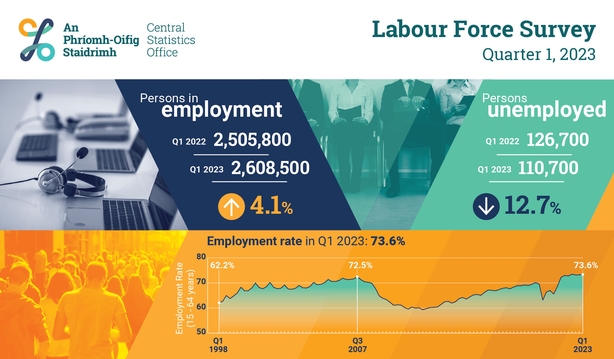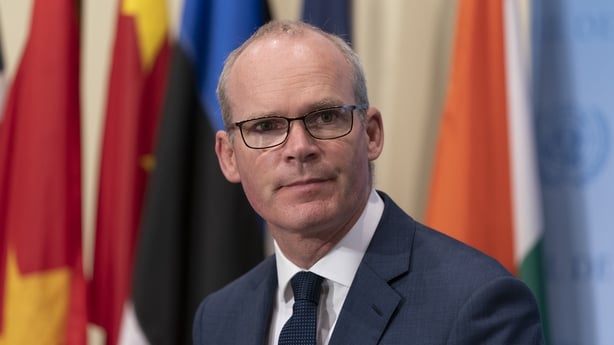There was a further increase in the number of people at work in the first three months of this year, according to the latest Labour Force Survey from the Central Statistics Office.
The number of people in employment rose by 102,700, or 4.1%, to 2,609,500 in the year to the end of the first quarter 2023.
This is the highest level of employment since the series began in 1998.
The estimated labour force, which includes both employed and unemployed, was 2,719,100, up 86,600 or 3.3%.
The overall participation rate was 64.9%, up slightly from 64.8% in the first quarter of 2022.
The employment rate for women aged 15-64 was 69.2%. This is another new record for women at work in the State.
The overall employment rate for both men and women aged 15-64 was 73.6% - another record high.
Today's figures show that there were 110,700 unemployed people between the ages of 15-74 in the first quarter of the year, which meant an unemployment rate of 4.1%. This is down from 4.8% in the same quarter last year.
The number of hours worked also increased, with the estimated number of hours worked per week at 83.9 million, an increase of 3.1 million hours or 3.8% compared to the first quarter 2022.
A contributing factor was the reduction in absences from work, which includes sick leave, which fell by 14.9% compared to the first quarter of 2022.
Just over a fifth, or 21.5% of those employed, worked part-time. The CSO estimates that a fifth of that group are "underemployed", which means they would like to work more hours.
The sectors which saw the biggest increases in employment were Administrative and Support Service Activities, which increased by 10.5% or 10,700 people, while the wholesale and retail sector went up by 9.8% or 29,500 people.
The largest decrease was in those working in Agriculture, Forestry and Fishing where numbers fell by 4,400 people or 4.3%.

The CSO estimates the increase in the labour force was made up of 79,400 additional workers through the "demographic effect" which includes changes in the size of the working age population but also immigration.
Another 7,300 people were added through the "participation effect" which means more people choosing to work who had been outside the labour force.
Today's data shows the additional number of non-Irish citizens employed rose by 67,700 in the year from the first quarter of 2022 to the first quarter of 2023.
The number of non-Irish citizens who joined the labour force over the same period was 67,100.
The number of Irish citizens in employment rose over the same period by 35,000 while the additional numbers in the labour force rose by 19,500 over the same period.
Another indicator, the Potential Additional Labour Force, classified as those "seeking work but not immediately available" and "available for work but not seeking work" fell from 81,000 in the first quarter of last year to 78,500 in the first quarter of this year.
Commenting on today's figures, Minister for Enterprise, Trade and Employment Simon Coveney said that more people are now employed in the country than ever before, with the monthly unemployment rate standing at just 3.9% in April.

"This is a considerable accomplishment given the challenges Ireland faced in recent years, including Brexit, the pandemic, the war in Ukraine and global inflationary pressures," the minister said.
"It is a testament to the hard work and remarkable resilience of Irish enterprise," he added.
Minister for Finance Michael McGrath said today's CSO figures represent remarkable growth in employment since the end of the pandemic, adding that more than 100,000 jobs have been added in the year to Q1 and almost 50,000 were added in the first quarter alone on a seasonally adjusted basis.
"Indeed, more than a quarter of a million jobs have been added since just before the pandemic. This is a significant achievement given the global economic headwinds faced in recent years and points to the success of Government policies introduced in response to these challenges," Mr McGrath said.
He said that looking ahead, labour supply is likely to remain a constraint on employment growth over the near term and this presents a growing risk that self-reinforcing wage-price dynamics could take hold.
"The Government will therefore continue to be vigilant of these risks to avoid the emergence of a wage-price spiral that could damage our competitiveness and impact our economy," he stated.






